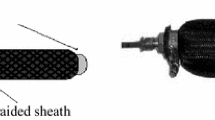Abstract
A pneumatic muscle (PM) system was studied to determine whether a three-element model could describe its dynamics. As far as the authors are aware, this model has not been used to describe the dynamics of PM. A new phenomenological model consists of a contractile (force-generating) element, spring element, and damping element in parallel. The PM system was investigated using an apparatus that allowed precise and accurate actuation pressure (P) control by a linear servovalve. Length change of the PM was measured by a linear potentiometer. Spring and damping element functions of P were determined by a static perturbation method at several constant P values. These results indicate that at constant P, PM behaves as a spring and damper in parallel. The contractile element function of P was determined by the response to a step input in P, using values of spring and damping elements from the perturbation study. The study showed that the resulting coefficient functions of the three-element model describe the dynamic response to the step input of P accurately, indicating that the static perturbation results can be applied to the dynamic case. This model is further validated by accurately predicting the contraction response to a triangular P waveform. All three elements have pressure-dependent coefficients for pressure P in the range 207 ⩽ P⩽ 621 kPa (30⩽ P⩽ 90 psi). Studies with a step decrease in P (relaxation of the PM) indicate that the damping element coefficient is smaller during relaxation than contraction.© 2003 Biomedical Engineering Society.
PAC2003: 8719Rr, 8719Ff, 8710+e, 8768+z
Similar content being viewed by others
REFERENCES
Baldwin, H. A. Muscle-like contractive devices. Bionics Symposium, Aeronautical Sys. Div./Aerospace Med. Div. Wright-Patterson AFB, 19–21 March 1963.
Caldwell, D. G. Compliant polymeric actuators as robot drive units. PhD thesis, University of Hull, 1989.
Caldwell, D. G., G. A. Medrano-Cerda, and M. Goodwin. Control of pneumatic muscle actuators. IEEE Control Syst. Mag.2:40–48, 1995.
Caldwell, D. G., N. Tsagarakis, and G. A. Medrano-Cerda. Bio-mimetic actuators: Polymeric pseudo muscular actuators and pneumatic muscle actuators for biological emulation. Mechatronics10:499–530, 2000.
Chou, C.-P., and B. Hannaford. Measurement and modeling of McKibben pneumatic artificial muscles. IEEE Transactions on Robotics and Automation12:90–102, 1996.
Fung, Y. C. Biomechanics: Mechanical Properties of Living Tissues, 2nd ed. New York: Springer, 1993, p. 568.
Hannaford, B., and J. M. Winters. Actuator properties and movement control: Biological and technological models. In: Multiple Muscle Systems: Biomechanics and Movement Organization, edited by J. M. Winters and S. L.-Y. Woo. New York: Springer, 1990, pp. 101–120.
Inoue, K. Rubbertuators and applications for robots. In: Robotics Research: The 4th International Symposium, edited by R. Bolles and B. Roth. Cambridge, MA: MIT Press, 1988, pp. 57–63.
Klute, G. K., and B. Hannaford. Accounting for elastic energy storage in McKibben artificial muscle actuators. Journal Dynamics Systems, Measurement, and Control122:386–388, 2000.
Noritsuga, T., and T. Tanaka. Application of rubber artificial muscle manipulator as a rehabilitation robot. IEEE/ASME Transactions on Mechatronics2:259–267, 1997.
Phillips, C. A., D. W. Repperger, D. B. Reynolds, and G. Bandry. Posture control strategy for enhanced human performance exoskeletons. Aviatation, Space, and Environmental Medicine73:296, 2002.
Repperger, D. W. Strength augmentation system design for US Air Force missions. Proceedings of the DARPA Soldier Enhancement Workshop: Exoskeletons for Human Performance Augmentation, Session II, edited by E. Garcia, 23 September 1999, pp. 1–20.
Repperger, D. W., K. R. Johnson, and C. A. Phillips. A VSC position tracking system involving a large scale pneumatic muscle actuator. Proceedings of the Conference on Decision and Control, Tampa, Florida, 16–18 Dec. 1998, pp. 4302–4307.
Repperger, D. W., C. A. Phillips, D. C. Johnson, R. D. Harmon, and K. Johnson. A study of pneumatic muscle technology for possible assistance in mobility. Proceedings of the IEEE EMBS, Chicago, 30 Oct.–2 Nov. 1997, pp. 1884–1887.
Repperger, D. W., C. A. Phillips, and M. Krier. Controller design involving gain scheduling for a large scale pneumatic muscle actuator. Proceedings of the Conference on Control Applications, Hawaii, 22–27 Aug. 1999, pp. 285–290.
Schulte, H. F. The characteristics of the McKibben artificial muscle. In: The Application of External Power in Prosthetics and Orthotics. Washington, DC: Pub. 874, National Academy of Science-National Research Council, 1961, pp. 94–115.
Tondu, B., and P. Lopez. The McKibben muscle and its use in actuating robot-arms showing similarities with human arm behavior. Ind. Robot24:432–439, 1997.
Winters, J. M. Braided artificial muscles: Mechanical properties and future uses in prosthetics/orthotics. 13th RESNA Conference, Washington, DC, 1990, pp. 173–174.
Author information
Authors and Affiliations
Rights and permissions
About this article
Cite this article
Reynolds, D.B., Repperger, D.W., Phillips, C.A. et al. Modeling the Dynamic Characteristics of Pneumatic Muscle. Annals of Biomedical Engineering 31, 310–317 (2003). https://doi.org/10.1114/1.1554921
Issue Date:
DOI: https://doi.org/10.1114/1.1554921




